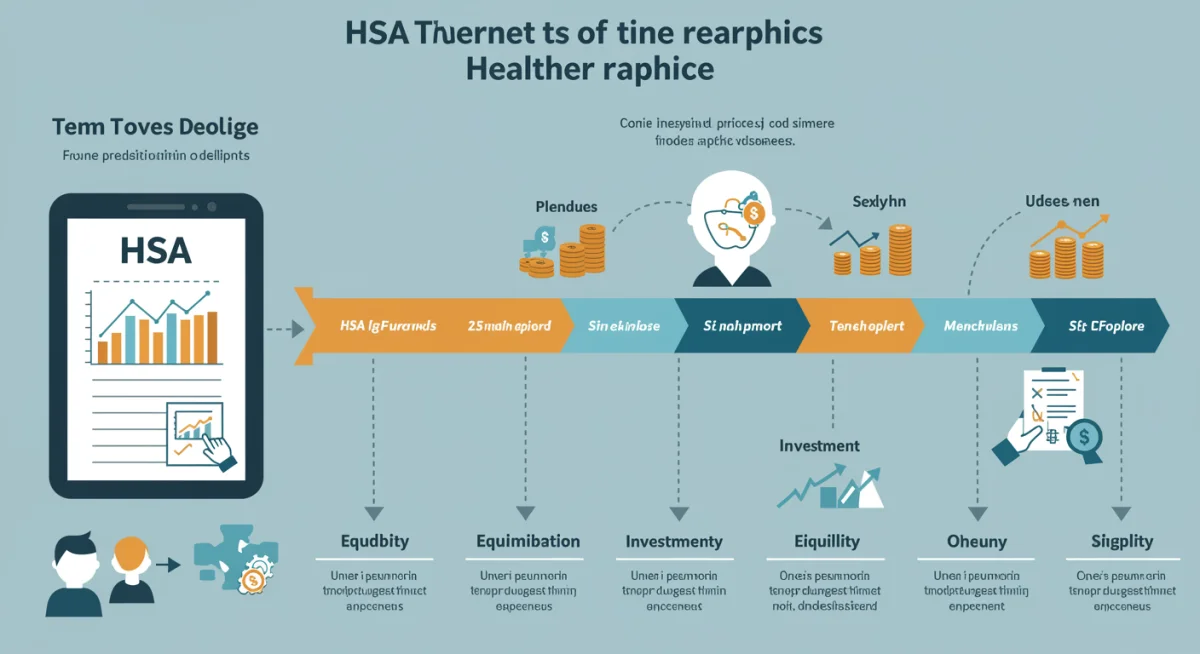Navigating 2025 HSA Contribution Limits: Maximize Tax-Free Growth

Understanding the 2025 HSA contribution limits is crucial for maximizing tax-advantaged healthcare savings and investment growth, offering a powerful tool for financial wellness and future medical expenses.
For individuals and families in the United States, effectively managing healthcare costs is a significant financial consideration. A key tool in this endeavor is the Health Savings Account (HSA), a powerful, triple-tax-advantaged savings and investment vehicle. This guide focuses on Navigating 2025 Health Savings Account (HSA) Contribution Limits: Maximize Your Tax-Free Growth, providing essential insights to optimize your healthcare savings and investments.
Understanding the Basics of HSAs and Eligibility
Before diving into the specifics of 2025 contribution limits, it is fundamental to grasp what an HSA is and who qualifies for one. An HSA is more than just a savings account; it is an investment vehicle linked to specific health insurance plans. This combination offers unique financial benefits that can significantly impact your long-term financial health.
Eligibility for an HSA is tied directly to enrollment in a High Deductible Health Plan (HDHP). The IRS sets specific criteria for what constitutes an HDHP, focusing on minimum deductibles and maximum out-of-pocket expenses. Meeting these criteria is the first step towards unlocking the advantages of an HSA, allowing you to contribute funds on a pre-tax basis.
What Defines a High Deductible Health Plan (HDHP)?
An HDHP is characterized by higher deductibles than traditional insurance plans, but typically comes with lower monthly premiums. For 2025, the IRS will likely adjust the minimum deductible and maximum out-of-pocket thresholds. These adjustments are usually announced later in the year, but understanding the general structure is vital for proactive planning.
- Minimum Deductible: This is the amount you must pay out-of-pocket for covered healthcare services before your insurance plan starts to pay. For HSA eligibility, this deductible must meet a certain IRS-mandated minimum.
- Maximum Out-of-Pocket: This represents the most you will have to pay for covered services in a plan year, including deductibles, co-payments, and co-insurance. Once this limit is reached, your health plan pays 100% of covered costs.
- Preventive Care Exemption: Many HDHPs cover preventive care services at 100% before the deductible is met, which is a significant benefit.
It is crucial to verify that your health plan meets these criteria annually, as slight changes can affect your HSA eligibility. Your insurance provider or employer’s benefits administrator can confirm if your plan qualifies as an HDHP for HSA purposes. Understanding these foundational elements ensures you are on the right path to leveraging your HSA effectively.
Anticipated 2025 HSA Contribution Limits
Each year, the Internal Revenue Service (IRS) adjusts the contribution limits for Health Savings Accounts to account for inflation. While the official 2025 limits are typically announced in the latter half of the preceding year, we can anticipate these figures based on historical trends and economic projections. These limits are critical as they define how much you can contribute to your HSA on a tax-advantaged basis.
The contribution limits vary depending on whether you have self-only HDHP coverage or family HDHP coverage. Additionally, individuals aged 55 and older are eligible for an extra ‘catch-up’ contribution, further enhancing their ability to save for future medical expenses. Staying informed about these anticipated figures allows for better financial planning and optimization of your savings strategy well in advance.
Projected Individual and Family Limits
Based on recent inflation rates and historical adjustments, we can project the 2025 HSA contribution limits. These projections are estimates and should be confirmed once the official IRS announcement is made. However, they provide a strong basis for initial financial planning.
- Self-Only Coverage: The individual contribution limit is expected to see an increase, likely placing it in the range of $4,300 to $4,400. This increase reflects the rising cost of healthcare and living expenses, allowing individuals to save more.
- Family Coverage: For those with family HDHP coverage, the limit is anticipated to be around $8,500 to $8,800. This higher limit acknowledges the greater potential healthcare costs associated with covering multiple family members.
- Catch-Up Contributions: Individuals aged 55 and over can typically contribute an additional $1,000 annually. This catch-up contribution is a fixed amount and is separate from the standard individual or family limits, designed to help older savers bolster their healthcare nest egg.
These limits apply to the total contributions made to your HSA from all sources, including employer contributions and your own pre-tax or post-tax contributions. It is essential to track these contributions carefully to avoid exceeding the annual maximums, which can result in tax penalties. Planning your contributions early in the year can help ensure you maximize your tax-free growth potential.
The Triple Tax Advantage: Why HSAs Are So Powerful
The appeal of a Health Savings Account lies in its unique triple tax advantage, a feature that distinguishes it from almost every other savings or investment vehicle available. Understanding these benefits is key to appreciating the full potential of an HSA as a cornerstone of your financial planning and healthcare strategy. This powerful combination of tax benefits can lead to substantial savings over time, especially when coupled with diligent investment.
Firstly, contributions to an HSA are tax-deductible or made pre-tax, reducing your taxable income in the year you contribute. Secondly, the funds in your HSA grow tax-free, meaning any interest, dividends, or capital gains earned on your investments are not subject to annual taxation. Finally, qualified withdrawals for eligible medical expenses are also tax-free, completing the triple advantage. This makes HSAs an incredibly efficient tool for managing current and future healthcare costs while simultaneously building wealth.
Breaking Down the Three Tax Benefits
Each component of the triple tax advantage works synergistically to create a highly effective savings and investment tool for healthcare.
- Tax-Deductible Contributions: Whether you contribute through payroll deductions (pre-tax) or directly from your bank account (and then deduct it on your tax return), your contributions reduce your taxable income. This immediate tax break can lead to significant savings each year.
- Tax-Free Growth: Unlike standard brokerage accounts where investment gains are taxed annually, the money invested within an HSA grows without being subject to federal income tax. This allows your investments to compound more rapidly, accelerating your wealth accumulation for healthcare.
- Tax-Free Withdrawals for Qualified Medical Expenses: When you use your HSA funds to pay for eligible medical expenses, these withdrawals are entirely tax-free. This includes a wide range of expenses, from doctor visits and prescription medications to dental and vision care. This final tax advantage makes the HSA a truly unparalleled savings vehicle for healthcare.
Beyond these primary benefits, HSAs offer remarkable flexibility. Unlike Flexible Spending Accounts (FSAs), HSA funds roll over year after year, never expiring. This means you can save and invest for future healthcare needs, including those in retirement, without the pressure of a ‘use-it-or-lose-it’ deadline. The ability to invest these funds further amplifies their long-term growth potential, making an HSA a powerful retirement planning tool.
Strategies for Maximizing Your HSA Contributions
Simply being eligible for an HSA and knowing the contribution limits is only the first step. The real financial advantage comes from actively maximizing your contributions and strategically utilizing the account. Developing a robust strategy ensures you fully leverage the triple tax benefits and build a substantial reserve for both anticipated and unexpected healthcare expenses. Proactive planning is essential to get the most out of your HSA.
One of the most effective strategies is to contribute the maximum allowable amount each year. This not only reduces your taxable income but also ensures that more funds are available for tax-free growth and future medical expenses. Consider setting up automated contributions to ensure consistency and avoid missing out on potential savings. Even small, regular contributions can add up significantly over time, especially when invested wisely.

Leveraging Employer Contributions and Catch-Up Provisions
Many employers recognize the value of HSAs and offer contributions as part of their benefits package. These employer contributions count towards your annual limit, so it’s important to factor them into your overall strategy. Taking full advantage of any employer match or contribution is essentially receiving free money for your healthcare savings.
- Employer Contributions: Inquire with your HR department about any employer contributions to your HSA. These can significantly boost your savings without requiring direct personal contributions, freeing up your cash flow for other financial goals.
- Catch-Up Contributions for Those 55 and Older: If you are 55 or older, remember to utilize the additional catch-up contribution. This extra $1,000 per year can make a substantial difference in preparing for healthcare costs in retirement, a period when medical expenses often increase.
- Automated Contributions: Set up a recurring, automated transfer from your paycheck or bank account to your HSA. This ‘set it and forget it’ approach ensures you consistently contribute and helps you reach the maximum limit without conscious effort.
Another powerful strategy involves using your HSA as an investment vehicle. Once your cash balance reaches a certain threshold, many HSA providers allow you to invest the funds in mutual funds, ETFs, or other investment options. By investing your HSA funds, you allow them to grow over time, potentially building a much larger nest egg for future medical expenses, particularly in retirement. This long-term investment approach transforms your HSA from a mere savings account into a significant wealth-building tool.
Investing Your HSA Funds for Long-Term Growth
While many view HSAs primarily as savings accounts for current medical expenses, their true potential lies in their capacity for long-term investment and tax-free growth. For those who can afford to pay for current medical expenses out-of-pocket, investing HSA funds can transform the account into a powerful, tax-advantaged retirement savings vehicle, specifically designed for healthcare costs. This strategy requires a shift in perspective, viewing the HSA not just as a spending account but as a critical component of a comprehensive financial plan.
The ability to invest HSA funds means your money can grow significantly over decades, mirroring the growth potential of a 401(k) or IRA, but with the added benefit of tax-free withdrawals for qualified medical expenses. This makes the HSA an incredibly attractive option for those looking to build substantial wealth for future healthcare needs, which are often a major financial concern in retirement. Understanding the investment options available through your HSA provider is the first step toward unlocking this growth.
Choosing the Right Investment Options
Most HSA providers offer a range of investment options, similar to those found in 401(k)s or IRAs. These typically include mutual funds, exchange-traded funds (ETFs), and sometimes individual stocks. The key is to select investments that align with your risk tolerance and long-term financial goals, much like any other investment portfolio.
- Diversification: Just as with other investment accounts, diversify your HSA investments across different asset classes (e.g., stocks, bonds) to mitigate risk and optimize returns.
- Low-Cost Funds: Opt for low-cost index funds or ETFs to minimize fees, which can eat into your long-term returns. Expense ratios can make a significant difference over decades of investing.
- Growth-Oriented Strategy: If you plan to use your HSA primarily for retirement healthcare expenses, consider a more aggressive, growth-oriented investment strategy in your younger years, gradually shifting to more conservative investments as you approach retirement.
It is important to remember that invested funds are subject to market fluctuations. Therefore, it is generally advisable to maintain a sufficient cash balance within your HSA to cover immediate or near-term medical expenses, while investing the remainder for long-term growth. This balanced approach ensures liquidity for current needs while maximizing the potential for future wealth accumulation. Consulting with a financial advisor can also provide personalized guidance on structuring your HSA investment strategy to best meet your individual needs and objectives.
Qualified Medical Expenses and Tax-Free Withdrawals
One of the most compelling aspects of a Health Savings Account is the ability to make tax-free withdrawals for qualified medical expenses. This final tax advantage completes the HSA’s triple benefit, making it an exceptionally powerful tool for managing healthcare costs. However, understanding what constitutes a ‘qualified’ medical expense is paramount to avoid potential tax penalties and ensure you fully benefit from your HSA.
The IRS provides extensive guidance on what expenses are considered qualified. Generally, these are expenses incurred for the diagnosis, cure, mitigation, treatment, or prevention of disease, and for treatments affecting any structure or function of the body. This broad definition covers a wide array of healthcare services and products, but it is always wise to consult official IRS publications or a tax professional if you are unsure about a specific expense.
Common Qualified Medical Expenses
The list of qualified medical expenses is comprehensive, encompassing many routine and specialized healthcare needs. Keeping detailed records of all medical expenses, even those you pay out-of-pocket, is a smart practice. This allows you to reimburse yourself from your HSA for past expenses at any point in the future, providing incredible flexibility.
- Doctor’s Visits and Co-pays: Fees for consultations with physicians, specialists, and other healthcare providers.
- Prescription Medications: Costs for prescribed drugs and certain over-the-counter medications with a doctor’s prescription.
- Dental and Vision Care: Includes expenses for cleanings, fillings, orthodontics, eye exams, glasses, and contact lenses.
- Hospital Stays and Surgeries: Major medical procedures and associated facility fees.
- Mental Health Services: Therapy, counseling, and other mental health treatments.
- Preventive Care: Screenings, vaccinations, and other services aimed at preventing illness.
It is crucial to note that if funds are withdrawn for non-qualified expenses before age 65, they are subject to income tax and a 20% penalty. After age 65, non-qualified withdrawals are only subject to income tax, similar to a traditional IRA. This further underscores the importance of using HSA funds strictly for qualified medical expenses. By diligently tracking and correctly utilizing your HSA for these expenses, you can maximize the tax-free benefits and effectively manage your healthcare expenditures throughout your life and into retirement.
Integrating HSAs into Your Broader Financial Plan
While HSAs are primarily associated with healthcare, their unique tax advantages and investment potential make them a valuable component of a holistic financial plan. Integrating your HSA effectively can complement other savings and investment vehicles, such as 401(k)s, IRAs, and taxable brokerage accounts, creating a more robust and tax-efficient financial future. This strategic approach considers your HSA as more than just a healthcare account; it views it as a powerful tool for overall wealth accumulation and retirement planning.
For many, the HSA can serve as a supplemental retirement account, particularly for covering healthcare costs in retirement, which often represent one of the largest expenses for retirees. By maximizing contributions and investing the funds for long-term growth, you can create a dedicated, tax-free source of funds for medical expenses later in life, potentially preserving your other retirement savings for other purposes. This foresight can significantly enhance your financial security during your golden years.
HSA as a Retirement Healthcare Fund
The ability of HSA funds to roll over year after year and grow tax-free makes them ideal for retirement healthcare planning. Unlike other retirement accounts, withdrawals for qualified medical expenses in retirement remain tax-free, providing an unmatched benefit.
- Long-Term Savings: Contribute consistently to your HSA throughout your working life, allowing the funds to compound over decades.
- Post-Age 65 Flexibility: After age 65, HSA funds can be withdrawn for any purpose without penalty, though non-qualified withdrawals will be subject to income tax. This flexibility essentially transforms the HSA into a traditional IRA once you reach retirement age, with the added benefit of tax-free medical withdrawals.
- Complementary to Other Accounts: Use your HSA to cover healthcare costs, allowing your 401(k) or IRA funds to be used for living expenses or other retirement goals, thereby optimizing your overall retirement income strategy.
Consider the potential for significant savings by paying for current, smaller medical expenses out-of-pocket and allowing your HSA funds to remain invested and grow. You can keep records of these out-of-pocket expenses and reimburse yourself from your HSA at any point in the future, even years later, provided the expenses were incurred after your HSA was established. This strategy, often referred to as ‘investing for reimbursement,’ allows your HSA investments to grow for a longer period, maximizing tax-free growth. By thoughtfully integrating your HSA into your broader financial strategy, you can bolster your financial resilience and ensure comprehensive coverage for your future healthcare needs.
| Key Aspect | Brief Description |
|---|---|
| Eligibility | Must be enrolled in a High Deductible Health Plan (HDHP) meeting IRS criteria. |
| Triple Tax Advantage | Contributions are tax-deductible, growth is tax-free, and qualified withdrawals are tax-free. |
| 2025 Contribution Limits | Projected increases for self-only ($4,300-$4,400) and family ($8,500-$8,800) coverage, plus $1,000 catch-up for 55+. |
| Investment Potential | HSA funds can be invested for long-term, tax-free growth, serving as a retirement healthcare fund. |
Frequently Asked Questions About 2025 HSA Limits
For 2025, the individual HSA contribution limit is projected to be between $4,300 and $4,400. This figure is an estimate based on inflation and historical adjustments. The official IRS announcement typically occurs later in the year, so it’s advisable to confirm once released.
The family HSA contribution limit for 2025 is anticipated to be in the range of $8,500 to $8,800. This higher limit applies to those with family High Deductible Health Plan (HDHP) coverage, allowing for greater savings for multiple covered individuals.
Individuals who are 55 years of age or older by the end of the tax year are eligible to make an additional catch-up contribution to their HSA. This additional amount is typically $1,000, allowing older savers to boost their healthcare funds.
Yes, many HSA providers allow you to invest your funds once a certain cash threshold is met. The primary benefit is tax-free growth, meaning any investment gains are not taxed. This makes HSAs powerful long-term savings vehicles for future medical expenses.
If you withdraw HSA funds for non-qualified expenses before age 65, the amount is subject to both income tax and a 20% penalty. After age 65, non-qualified withdrawals are only subject to income tax, similar to traditional IRA distributions.
Conclusion
The Health Savings Account remains an indispensable tool for managing healthcare costs and building long-term financial security. By understanding and proactively navigating 2025 HSA contribution limits, individuals and families can significantly maximize their tax-free growth potential. From leveraging the triple tax advantage to strategically investing funds and integrating the HSA into a broader financial plan, the benefits extend far beyond immediate medical expenses, offering a robust solution for future healthcare needs and even retirement planning. Staying informed about IRS guidelines and optimizing your contributions will ensure you fully harness the power of your HSA, securing a healthier and wealthier financial future.





